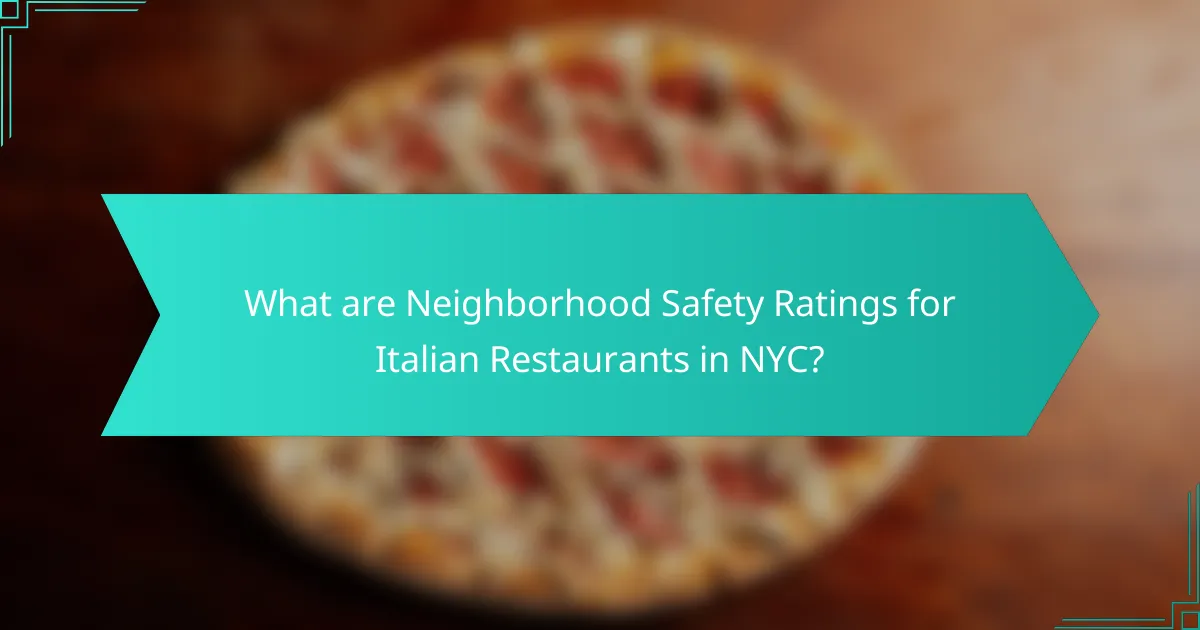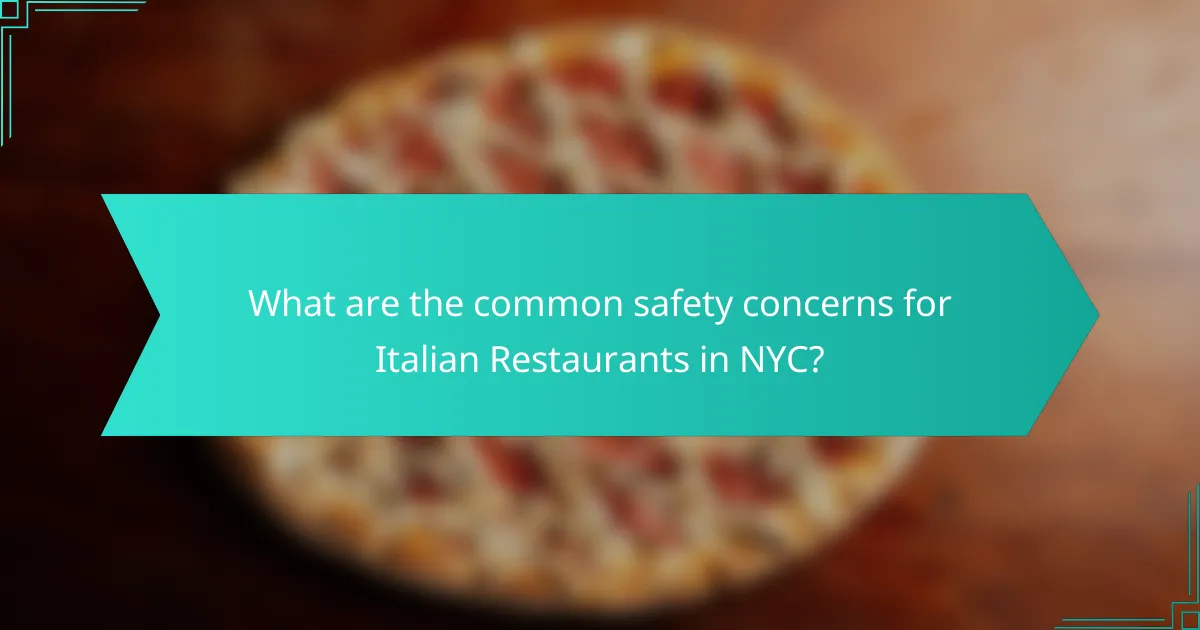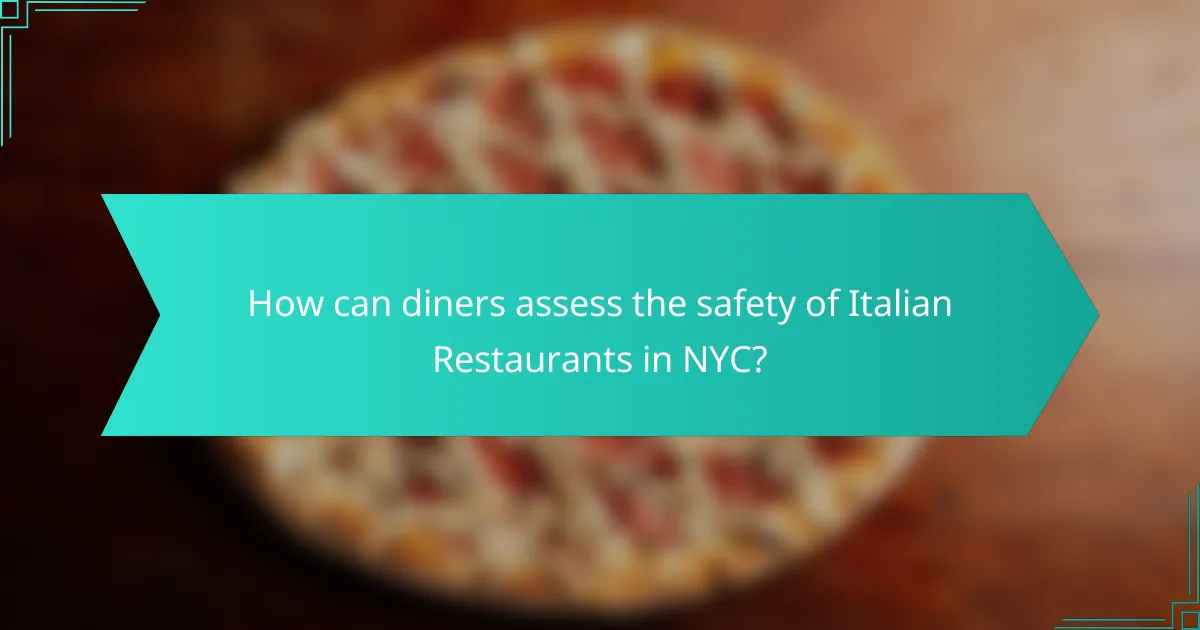Neighborhood safety ratings play a crucial role in assessing Italian restaurants in New York City (NYC), as these ratings vary significantly by location. Restaurants situated in safer neighborhoods, such as Manhattan’s Upper East Side and West Village, typically receive higher safety ratings compared to those in areas like the Bronx. Safety concerns encompass food safety, fire hazards, and customer safety, which are essential for maintaining a secure dining environment. Diners can evaluate restaurant safety by reviewing health inspection scores, customer feedback, and local crime data, ensuring they make informed decisions when choosing where to eat.

What are Neighborhood Safety Ratings for Italian Restaurants in NYC?
Neighborhood safety ratings for Italian restaurants in NYC vary by location. Restaurants in safer neighborhoods generally receive higher ratings. Areas like Manhattan’s Upper East Side and West Village are known for their low crime rates. In contrast, some neighborhoods in the Bronx may have lower safety ratings. These ratings are often derived from crime statistics and community reports. Websites and apps that provide restaurant reviews frequently include safety information. Local law enforcement agencies also publish crime data that can be referenced for safety ratings. Overall, patrons should consider both restaurant quality and neighborhood safety when dining out.
How are Neighborhood Safety Ratings determined for Italian Restaurants?
Neighborhood Safety Ratings for Italian restaurants are determined by analyzing crime statistics in their vicinity. Local law enforcement agencies provide data on reported incidents. This data includes types of crimes, frequency, and severity. Ratings also consider community feedback and reviews regarding safety. Additionally, factors like lighting, foot traffic, and the presence of security measures are evaluated. Geographic information systems may be used to visualize crime patterns. Ratings help consumers assess the safety of dining locations. Research shows that neighborhoods with lower crime rates tend to have higher restaurant patronage.
What factors contribute to the safety ratings of these restaurants?
Safety ratings of restaurants are influenced by several factors. These factors include health inspection scores, food handling practices, and employee training. Local crime rates also play a significant role in determining safety perceptions. Customer reviews often reflect personal safety experiences, impacting ratings. Proximity to emergency services can enhance safety ratings. Compliance with health regulations ensures a safe dining environment. Regular maintenance and cleanliness of the establishment contribute to overall safety. Lastly, community engagement and reputation can affect how safe a restaurant is perceived to be.
How do crime statistics influence safety ratings?
Crime statistics directly influence safety ratings by providing measurable data on criminal activity in specific areas. Higher crime rates typically lead to lower safety ratings. Conversely, areas with lower crime rates receive better safety ratings. Safety ratings are often based on reported incidents such as theft, assault, and vandalism. For example, a neighborhood with a significant decrease in violent crime may see an improvement in its safety rating. Studies show that consumers consider safety ratings when choosing dining locations. Thus, crime statistics play a critical role in shaping public perception of neighborhood safety.
Why are Neighborhood Safety Ratings important for diners?
Neighborhood safety ratings are important for diners because they provide insights into the safety and security of areas where restaurants are located. These ratings help diners assess potential risks before visiting. For instance, a higher safety rating often correlates with lower crime rates, making diners feel more secure. According to a study by the National Institute of Justice, neighborhoods with better safety ratings see increased foot traffic and customer satisfaction. This data suggests that diners prioritize safety when choosing dining locations. Ultimately, these ratings influence dining decisions and contribute to a positive dining experience.
How do safety ratings affect customer choices?
Safety ratings significantly influence customer choices. Customers often prioritize safety when selecting dining locations. High safety ratings can attract more patrons. Conversely, low ratings may deter potential customers. Research indicates that 70% of diners consider safety ratings before visiting a restaurant. This trend is particularly evident in urban areas like NYC. Customers are more likely to choose restaurants in neighborhoods with favorable safety ratings. Thus, safety ratings play a crucial role in shaping consumer behavior in the restaurant industry.
What role does safety play in the dining experience?
Safety is a crucial aspect of the dining experience. It influences customer decisions and overall satisfaction. A safe environment fosters trust in the restaurant. Customers are more likely to return when they feel secure. Safety includes aspects like cleanliness and staff training. According to a survey, 70% of diners prioritize safety when choosing a restaurant. Moreover, restaurants with high safety ratings often see increased patronage. Thus, safety significantly impacts the dining experience and business success.

What are the common safety concerns for Italian Restaurants in NYC?
Common safety concerns for Italian restaurants in NYC include food safety, fire hazards, and customer safety. Food safety issues often arise from improper food handling and storage. This can lead to foodborne illnesses, which are a significant risk in the restaurant industry. Fire hazards are prevalent due to cooking equipment and flammable materials. Restaurants must comply with fire codes to mitigate these risks. Customer safety is also a concern, especially regarding slips and falls. Proper maintenance of floors and walkways is essential to prevent accidents. Additionally, security issues such as theft or altercations can pose risks to both staff and patrons. Regular safety inspections and employee training are vital for addressing these concerns effectively.
How do neighborhood crime rates impact Italian Restaurants?
Neighborhood crime rates negatively impact Italian restaurants. Higher crime rates can deter customers from visiting these establishments. Safety concerns lead to reduced foot traffic in affected areas. Restaurants in safer neighborhoods generally experience higher patronage. According to a study by the National Restaurant Association, crime rates influence consumer behavior significantly. Areas with lower crime rates often see increased dining out frequency. Consequently, Italian restaurants in high-crime neighborhoods may struggle with profitability. This correlation highlights the importance of neighborhood safety for restaurant success.
What types of crimes are most prevalent near these restaurants?
The most prevalent types of crimes near Italian restaurants in NYC include theft, assault, and drug-related offenses. These crimes often occur in urban areas with high foot traffic and nightlife. According to the NYPD crime statistics, theft accounts for a significant portion of reported incidents in restaurant-heavy neighborhoods. Assaults are also common, particularly late at night when patrons are leaving establishments. Drug-related offenses can increase in areas with a concentration of nightlife, impacting overall safety. These patterns highlight the need for enhanced security measures in these locations.
How can restaurants mitigate safety risks in their neighborhoods?
Restaurants can mitigate safety risks in their neighborhoods by implementing various strategies. They can enhance security measures, such as installing surveillance cameras and hiring security personnel. Establishing good relationships with local law enforcement can also improve safety. Participating in neighborhood watch programs encourages community involvement. Restaurants should maintain well-lit exteriors to deter criminal activity. Training staff on emergency protocols prepares them for potential incidents. Collaborating with local organizations can foster a safer environment. These actions contribute to a reduction in crime rates, enhancing overall neighborhood safety.
What safety measures do Italian Restaurants implement?
Italian restaurants implement various safety measures to ensure the well-being of their patrons and staff. These measures include regular health inspections to comply with food safety regulations. Restaurants often train staff in proper food handling techniques to prevent contamination. Additionally, they maintain cleanliness and sanitation in food preparation areas. Many establishments also have fire safety protocols in place, including functioning fire extinguishers and evacuation plans. Surveillance cameras are commonly installed to enhance security and deter crime. Emergency exits are clearly marked and accessible for quick evacuation. Furthermore, some Italian restaurants conduct background checks on employees to ensure a safe environment. These practices collectively contribute to a safer dining experience for customers.
What security features are commonly found in these restaurants?
Common security features found in Italian restaurants in NYC include surveillance cameras, alarm systems, and secure entry points. Surveillance cameras monitor the premises, deterring potential criminal activity. Alarm systems alert authorities in case of emergencies or breaches. Secure entry points often include reinforced doors and locks, enhancing overall safety. Additionally, many restaurants employ trained security personnel during peak hours. Adequate lighting around the restaurant’s exterior further improves safety. These features collectively contribute to a safer dining environment for patrons and staff.
How do staff training programs enhance safety in restaurants?
Staff training programs enhance safety in restaurants by equipping employees with essential knowledge and skills. These programs cover food safety practices, emergency procedures, and proper equipment handling. Trained staff can identify hazards and respond effectively to emergencies. Research shows that restaurants with comprehensive training reduce incidents of foodborne illnesses by up to 30%. Additionally, trained employees are more likely to follow safety protocols consistently. This adherence minimizes risks and creates a safer environment for both staff and customers. Overall, effective training programs lead to improved safety standards in restaurant operations.

How can diners assess the safety of Italian Restaurants in NYC?
Diners can assess the safety of Italian restaurants in NYC by checking health inspection scores. The New York City Department of Health provides public access to these scores online. Diners should look for restaurants with an A grade, indicating compliance with health and safety regulations. Additionally, reading recent customer reviews can offer insights into safety experiences. Social media platforms often feature real-time feedback from patrons. Checking for visible health and safety practices, such as staff wearing masks and cleanliness, is also important. Local news reports may highlight any safety issues related to specific restaurants. Lastly, consulting neighborhood safety ratings can provide context on crime rates in the area surrounding the restaurant.
What resources are available for checking safety ratings?
Resources for checking safety ratings include government websites, consumer advocacy groups, and online review platforms. The National Highway Traffic Safety Administration (NHTSA) provides vehicle safety ratings. The Insurance Institute for Highway Safety (IIHS) offers crash test ratings. Local health departments publish restaurant inspection scores. Websites like Yelp and TripAdvisor feature user reviews and safety comments. These platforms aggregate data and provide insights into safety standards.
How can online reviews inform diners about restaurant safety?
Online reviews can inform diners about restaurant safety by providing firsthand accounts of experiences. Customers often share their observations regarding cleanliness and hygiene practices. Reviews may highlight any safety violations or health concerns encountered during visits. For instance, a review might mention unclean tables or improper food handling. Such details can alert potential diners to issues before they visit. Studies show that 84% of consumers trust online reviews as much as personal recommendations. This trust makes reviews a valuable resource for assessing safety in restaurants. Overall, online reviews serve as a critical tool for diners to evaluate the safety of dining establishments.
What local agencies provide safety information for neighborhoods?
Local agencies that provide safety information for neighborhoods include police departments, fire departments, and local health departments. Police departments offer crime statistics and safety tips for residents. Fire departments provide information on fire safety and emergency preparedness. Local health departments may share data on health risks and environmental safety. These agencies often have websites or community outreach programs to disseminate information. For example, the New York City Police Department provides crime maps and safety resources online.
What tips can diners use to ensure their safety while dining?
Diners can ensure their safety while dining by following several key tips. First, they should choose restaurants with high safety ratings. Checking online reviews can provide insights into the restaurant’s safety practices. Second, diners should be aware of their surroundings. This includes noting exits and observing any suspicious behavior. Third, they should avoid dining alone, especially in unfamiliar areas. Dining with a group enhances personal safety. Fourth, using reputable transportation options to and from the restaurant is crucial. This minimizes exposure to potential dangers. Lastly, diners should trust their instincts. If a situation feels unsafe, they should leave immediately. These practices help create a safer dining experience.
How can diners choose safer neighborhoods for dining out?
Diners can choose safer neighborhoods for dining out by researching crime statistics and neighborhood safety ratings. Online resources like local police department websites provide crime data. Websites such as NeighborhoodScout or SpotCrime offer detailed safety ratings for specific areas. Diners should also consider reviews on platforms like Yelp or Google, which may mention safety concerns. Observing the neighborhood during different times of the day can provide insight into its safety. Additionally, asking locals about their experiences can help gauge the safety of an area. According to a 2021 report by the NYC Department of Criminal Justice Services, neighborhoods with lower crime rates generally correlate with higher restaurant ratings.
What precautions should diners take when visiting Italian Restaurants?
Diners should take several precautions when visiting Italian restaurants. First, they should check the restaurant’s health inspection scores. This information is often available online or posted at the restaurant. Second, diners should review recent customer feedback. Online reviews can provide insights into the quality of food and service. Third, it is advisable to visit during peak hours. Busy restaurants often indicate a higher turnover of food, ensuring freshness. Fourth, diners should be cautious about food allergies. Informing the staff about allergies can prevent adverse reactions. Lastly, diners should be aware of their surroundings. Staying alert can enhance personal safety and comfort.
Neighborhood Safety Ratings for Italian Restaurants in NYC serve as a crucial metric for diners assessing the safety and security of dining locations. These ratings are influenced by crime statistics, community feedback, and safety measures implemented by the restaurants. The article explores how safety ratings are determined, the factors contributing to these ratings, and their impact on consumer choices. It also highlights common safety concerns, available resources for checking safety ratings, and practical tips for diners to ensure their safety while enjoying Italian cuisine in the city.